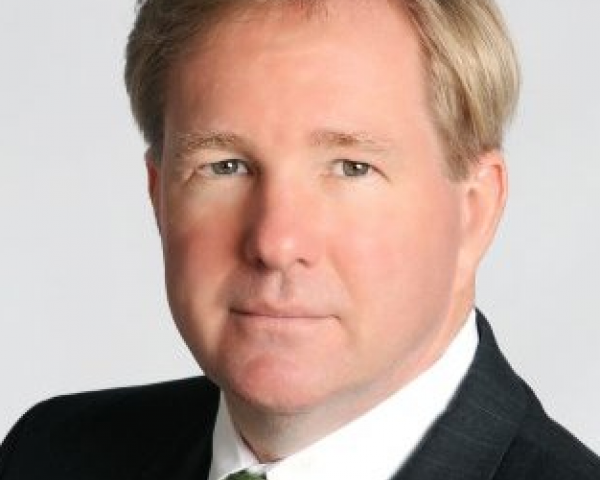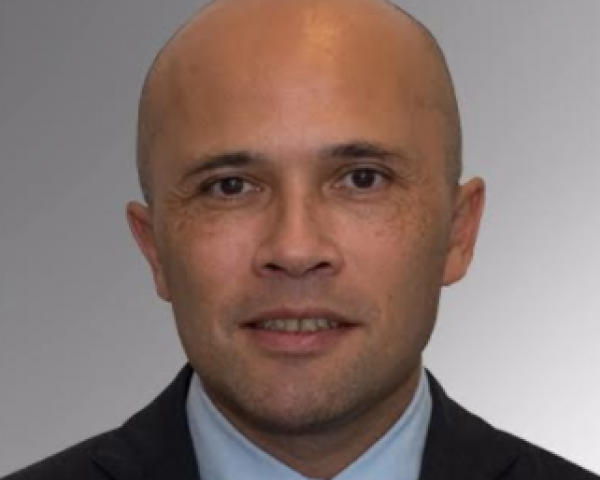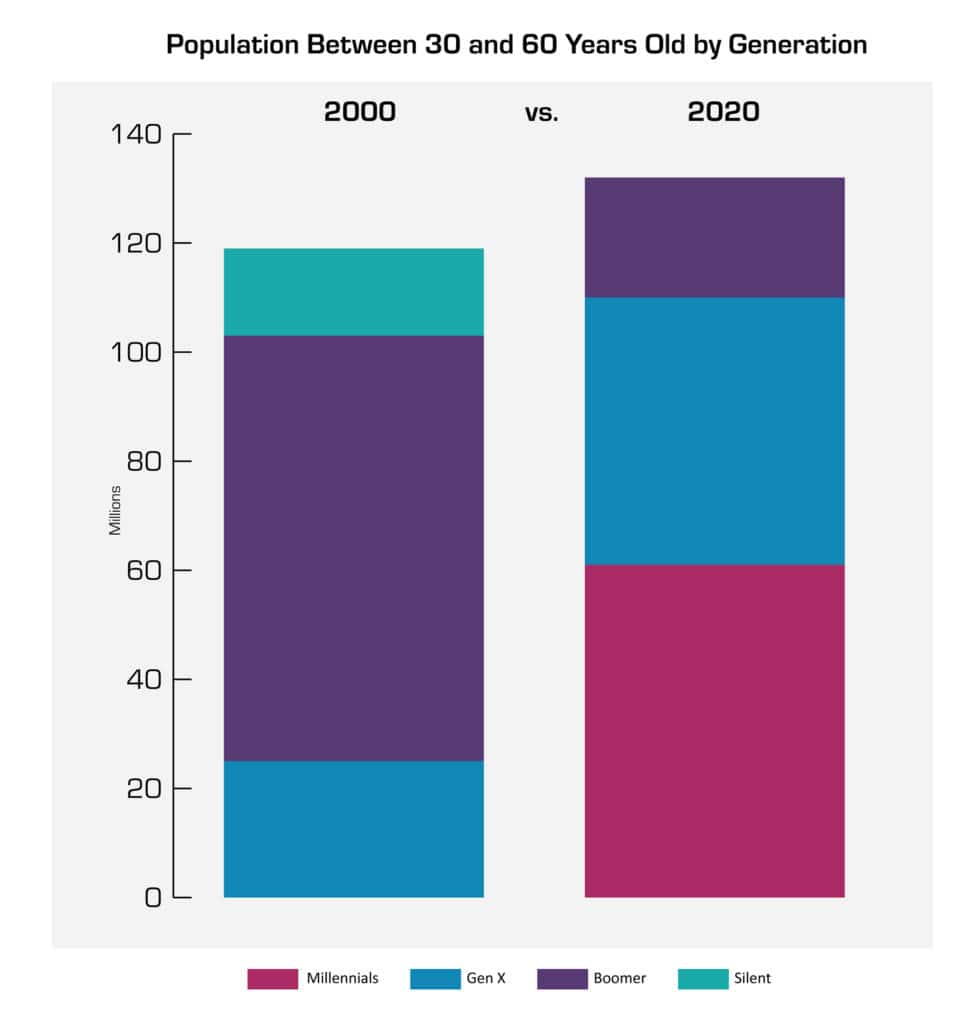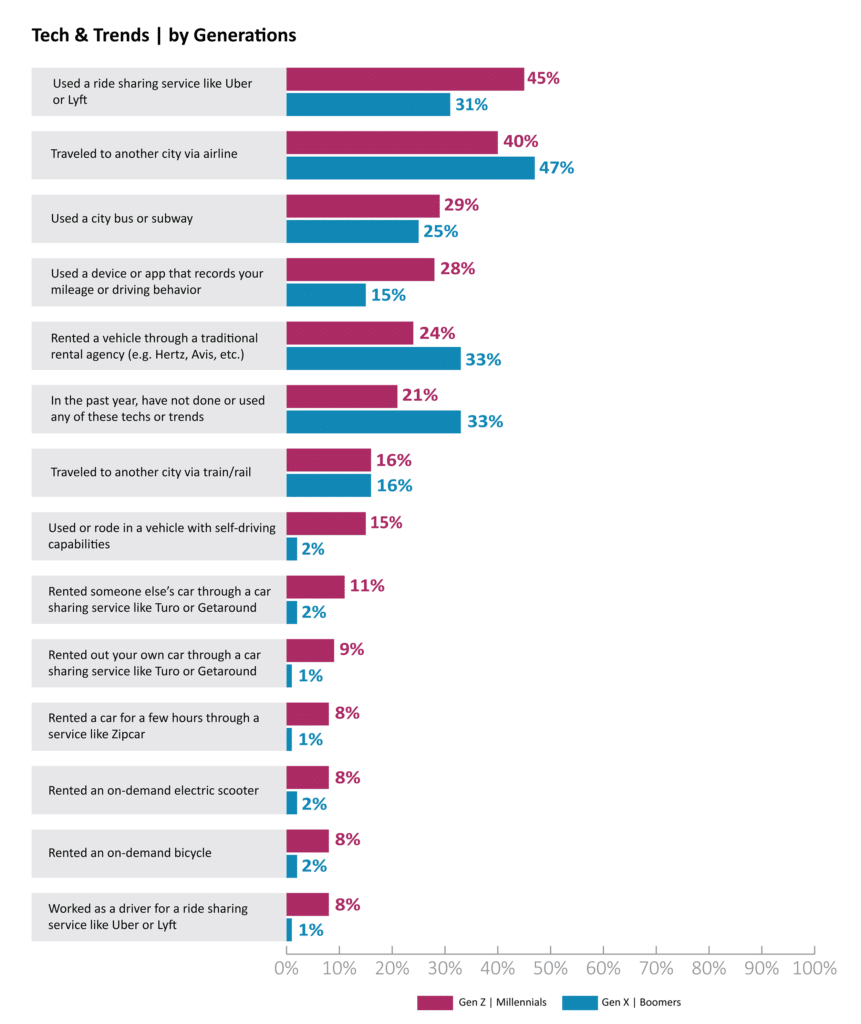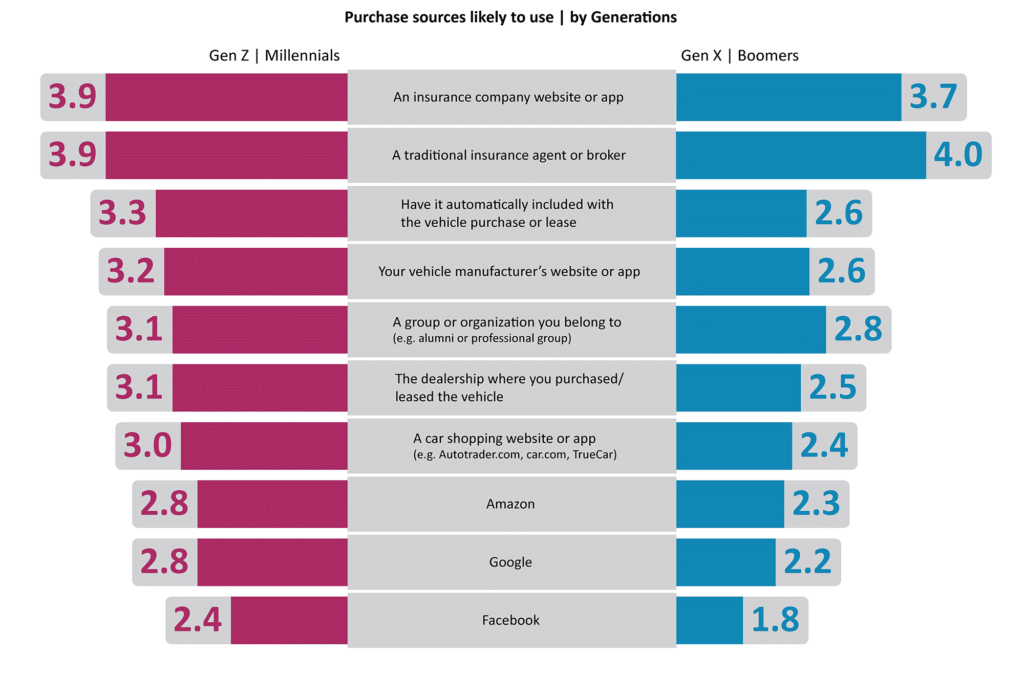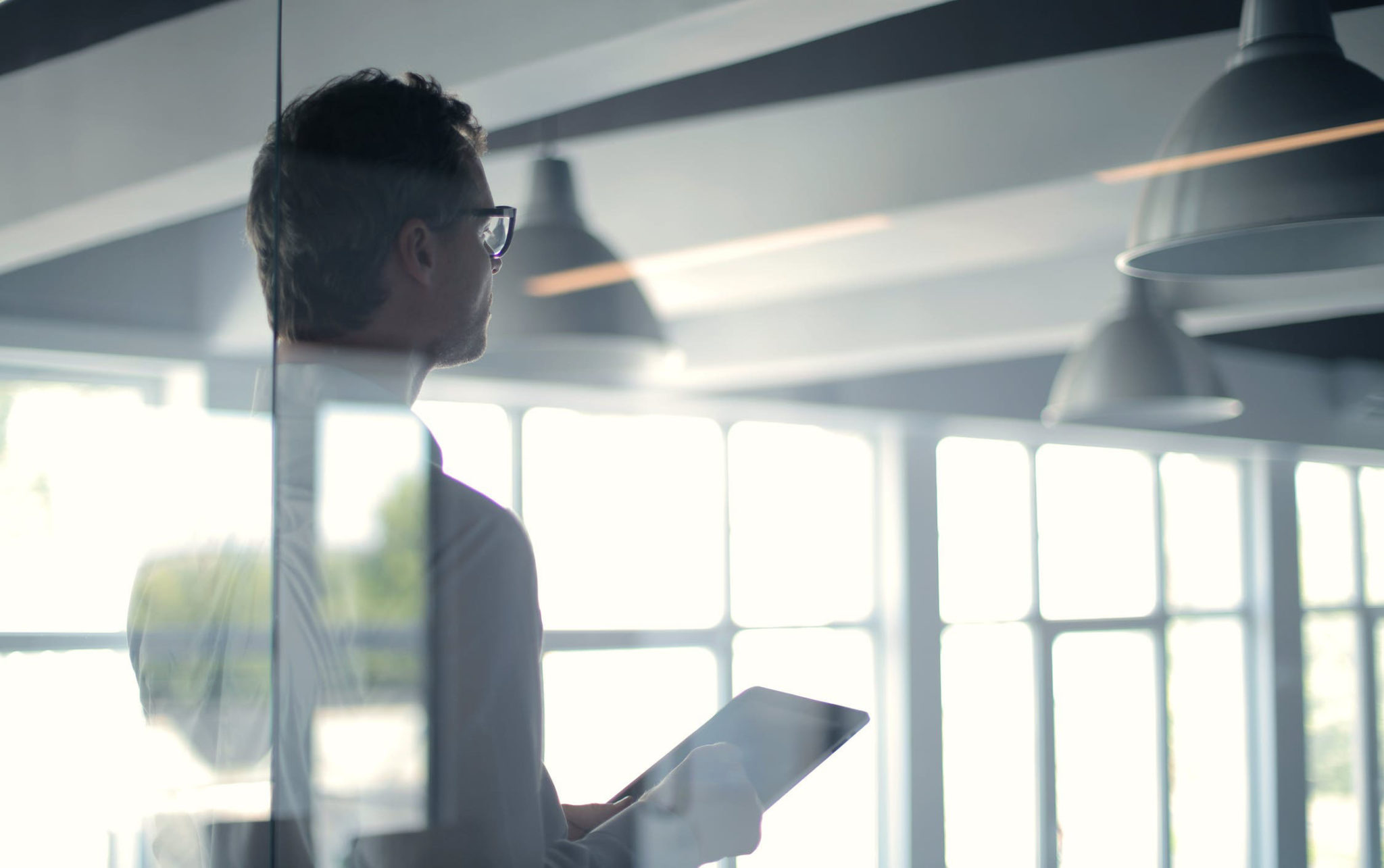The world is experiencing a unique situation. Over the past months, hundreds of millions of people from all over the globe have been forced to stay home, overnight. The economy came to a halt. The current pandemic determines what we talk about, what we can do and what our future looks like. Besides all the necessary short-term measures, insurers also need to think beyond the current crisis to a future that may be very different. We have identified four post-COVID trends that insurers should definitely tap into.
Waking up in a different world — and rapidly adapting to it
During the first couple of weeks, we found ourselves in a post-apocalyptic movie like "Mad Max." High streets turned into ghost towns. Mass panic buying began of all types of shelf-stable food, survival gear and water. In the U.S., according to Yelp, gun interest went up 360%, as if people were preparing for the end of time. But human adaptability turned out to be astonishing. Very quickly, everyone tried to make the best out of the changed situation. Where we cannot follow our old routines any more, like going to the supermarket to get groceries, people immediately find an alternative by meeting their needs online. And when we could not work at the office any more, we almost seamlessly continued at home, even while combining this with home-schooling for kids. The scale of change in consumer behavior, in such a short time, has been gigantic and unprecedented.
Trying out new things
For a lot of people, the current situation provides a reason to try new things. DIY stores and garden centers watch their revenues rise. Baking pies and playing board games have become popular activities. Alcohol consumption went up by 42% in the San Francisco Bay Area, and in China divorces significantly increased. This is an interesting time for behavioral scientists.
The world is about to open again, little by little
In many countries, the lockdown measures are alleviated little by little. Now that the world is becoming open to us again, we can start giving more attention to the post-pandemic future.
Some expect, or hope, that everything will get back to how it used to be. We believe that because of COVID-19 we entered a new era. Not only because of the economic crisis, but mostly because COVID-19 has the potential to create more permanent changes in customer perceptions and behavior. A number of COVID-19-related shifts in customer behavior are temporary, purely based on coping with the crisis, but other, more fundamental shifts are here to stay.
Although we know that the pandemic will eventually wane, a significant part of our new behavior will stick. Insurers that also want to be successful after the crisis have to understand this new behavior and turn this understanding into propositions and experiences that strike the right chord. They should start thinking ahead and reimagining the way they can stay relevant after the dust has settled.
4 Key Post-COVID-19 Trends Insurers Should Tap Into
We believe that, specifically for the insurance industry, the current crisis amplifies four consumer trends that determine the priorities of insurance customers and what they will value in a post-COVID-19 world. These four trends should serve as inspiration to reimagine the future of insurance beyond COVID-19. Let’s take a closer look at each of these trends.
Trend #1: Health First — More Than Ever
If one thing became clear during the last couple of months, it is that at the end of the day there is nothing of greater importance than your life and health. And almost everyone agrees to that. Individuals, governments and businesses around the world do everything to protect themselves, their families, their citizens and their employees. Virtually everyone is prepared to make huge sacrifices; to drastically change the way we live. Even to put our entire economy in jeopardy.
We notice people not just staying at home but also paying way more attention to health than before. What we learn about the virus contributes to that. Not only do pre-existing conditions such as cardiovascular diseases and diabetes increase the chances of complications and death but so do conditions such as being overweight and having excess belly fat. As a result, people are starting to exercise more and eat healthier.
More exercise
The millions stuck at home are keen to exercise, not only because they are bored but also because they want to improve their lifestyle. According to Yelp, interest in home fitness equipment has shot up 344%, and hiking is up by 116%. Yoga mats and kettle bells, but also bicycles, are selling like toilet paper. The online wellness industry is booming, as well. Meditation apps, digital fitness classes and online platforms such as Peloton, a home exercise-bike company, are growing fast. Subscriptions to workout video channels more than doubled. Videoconferencing platform Zoom, through which many workout, yoga and dance classes are broadcast, has become one of the most important "social wellness" platforms.
More healthy food
Food trends that were already on the radar are now becoming even more important. Data shows that, as social distancing persists, home cooking is on the rise. Online cooking courses are booming. People are becoming more health-conscious and spending more time in their own kitchens, which will further the growing demand for fresh, healthy and additive-free food. People are looking for products that suit their lifestyles and the life stage they are in, and that reduce health risks. Fruit and veggie shops are up by 102%, according to Yelp. LiveHelfi, a leading online functional food and supplement retailer, saw a sales increase of 75% in just three months. Personal nutrition schemes increase, as well.
More self-tracking
All sorts of health apps experience growing popularity. People value the sense of having control over things, now more than ever. So they monitor what they do, how they sleep, what they eat, how they feel, how much they exercise and so on -- self-knowledge through self-tracking with the use of technology. An increasing number of people wear self-tracking devices on their skin providing data that even goes under the skin. It doesn’t get more personal, more intimate.
More willingness to share data
With an identified contamination, you want to have a quick and complete understanding of who that person had contact with to control the spread of the virus. Several countries immediately made efforts to use data from smart phones:
- The government of Singapore came up with a community-driven contact tracing app called Trace Together. The app is able to identify people who have been within two meters of coronavirus patients for at least 30 minutes, using Bluetooth. Infected individuals can choose to allow the ministry of health to access the data in the app to identify those close contacts.
- YiTong Health, from China, launched a monitoring platform for employers to monitor the health of employees. The tool generates daily health reports of employees and an automatic evaluation of COVID-19 risks, and provides precaution courses for employees.
- LingBan provides a chatbot solution for communities to monitor the COVID-19 situation. It automatically makes daily phone calls to the community members with a high risk of infection to check the health status of the neighborhood and with COVID-19. AI helps to perform tracking, monitoring and reducing further risk.
All examples above are Asian. Although the importance attached to privacy differs per geography, we notice the adoption of similar solutions in other regions, as well. In just a few days, the Australian government’s COVIDsafe app had been downloaded millions of times. In Norway, more than 25% of the population has downloaded the coronavirus tracker smartphone app Smittestopp (Infection Stop) of the Norwegian Institute of Public Health in its first week. Apparently, many Australians and Norwegians are willing to play an active role themselves to prevent the spread of the virus and to share some of their personal data because it provides substantial benefits. It proves that reciprocity is the only way to solve the privacy issues that consumers have with sharing data.
More pressure on the health system
The lockdowns had much to do with the pressure experienced on every part of the health system. In hospitals, the occupancy rate of intensive care units has been way above 100% for months. Taking care of elderly relatives is massively impaired by the corona crisis. GPs quickly adopted online channels to avoid unnecessary movement and physical contact. They found that online appointments are more time-efficient, and most will continue to use online channels more than they used to. The sense of urgency for digital health solutions as well as the benefits are now clearer than ever.
Health First — Opportunities to Seize
- Health insurance: Many expect the volumes in health and life insurance to grow in the next few years. The pandemic enhances the overall concern for personal health and wellbeing. It will make consumers more aware of the importance of adequate life and health insurance plans.
- Pre-active and preventive services beyond traditional insurance: This has been widely discussed for some time now. The added value of an insurer is shifting from only covering risk when there is damage, to rendering preventive services as a substantial part of the offering. It will take a while before a vaccine is developed and everyone is vaccinated. Instead of simply waiting for that to happen, efforts can be made to prevent contamination and to promote a healthier lifestyle. By eating better and exercising more you become more resilient. Insurers should play an active role, or even take the lead, in promoting a healthier lifestyle with tangible services. This would also immediately increase the social impact of the insurance industry.
- Data-drive health and wellness platforms: Platforms that combine self tracking, data and all sorts of incentives to help customers with healthier habits will become even more relevant than they already are. In the long term. personalized nutrition may even accelerate the cross-over between food, tracking and advanced analytics. Connected health devices combined with these platforms form the foundation for entirely new business models in the health insurance sector; shifting from a transactional to a relational, collaborative, participatory model, assisting customers to manage their health over time. Quite a few insurers are already exploring such platforms; either by developing these from scratch themselves or by teaming up with an existing platform and immediately leveraging the expertise of an experienced provider, such as dacadoo, PAI Health, Virgin Pulse, Vitality or Wellmo. Insurers need to move from exploration to adoption at scale.
- Active participation by customers: Trackers and platforms provide actionable information and insights that users can act upon. In turn, this allows a much more active role for customers within insurance products and services. The "quantified self" movement and the adoption of COVID-19-tracking apps clearly show not only the consumers’ need for more control and empowerment, but also the desire and readiness to take a more active approach in assessing symptoms, connecting with healthcare providers and improving self-management of care. Active participation allows customers to take more responsibility, leading to more equality in the relationship with insurers. This is a fundamental shift in the relationship and a great new perspective on innovation.
- Ecosystems with health providers: Current health systems are not sustainable due to the rapidly aging population and rising healthcare costs. Connected healthcare devices allow healthcare providers as well as health insurers to extend their reach and interactions with patients. Sharing data among all stakeholders, optimal use of this data and remote patient monitoring have the potential to change the way of working entirely, keeping healthcare efficient, affordable and accessible. The application of all sorts of connected devices, telemedicine solutions and advanced algorithms improve patient care, while decreasing total health care costs across the health ecosystem. These applications need to be taken to the next level, for instance by providing home-care solutions and flexible opportunities to engage with care providers for the elderly and the individuals that live independently.
See also: Step 1 to Your After-COVID Future
Examples of the wide variety of innovative tech providers that link insurers to health ecosystems:
- Telemedi.co (Poland): Decreasing medical costs for insurance companies using telemedicine and AI solutions.
- Mediktor (Spain): Supports health insurance clients from symptoms to the best action within five minutes.
- Medlanes (Germany): On-demand digital network, leveraging blockchain to access quality-assured medical providers while controlling costs for health and life insurers.
- Infermedica (Poland): AI-powered platform that makes it easier to pre-diagnose, triage and connect patients with the appropriate medical services.
- Breathomix (The Netherlands/Romania): Cloud-based breath analysis solution for rapid and efficient diagnoses of different types of diseases, empowering personalized medicine.
- reFit Systems (Mexico/Germany): Digital therapy system for individual rehabilitation, developing state-of-the-art digital solutions for healthcare and medical technology.
- Vayyar (Israel): Provides valuable insights into the health of elderly persons, reducing costs of emergency medical services and long-term hospitalization.
- HiNounou (China/Singapore): Wellness ecosystem and platform for seniors and their families.
- Neurotrack (U.S.): Cognitive health platform helping to assess risk for memory loss, and providing tools to prevent and manage cognitive decline.
- Somnox (The Netherlands): On a mission to improve people’s lives by sleeping with a robot.
Trend #2: Connected Living — Now For Real
Shift to digital on fast-forward
COVID-19 put the shift to digital on fast-forward. The whole planet just had a crash course in connected living. Working from home, days filled with virtual meetings on Zoom, Teams or Meet. Shopping for everything online, from groceries to fashion and electronics. Remote classes for children instead of going to school. Streaming movies. Online workouts and yoga classes. Ordering food, even from the finest restaurants. Having drinks with friends on Zoom. Worshipping from home. Even attending a funeral online in real time. It all became kind of normal in a short time.
After years of incremental change in small steps, digital routines were embraced within a few weeks. The longer we keep on following new routines, the bigger the chance that these changes will stay. Consequently, all kinds of aspects of connected living have become normal. What we currently experience is a fundamental shift in how people will live and work.
- Under quarantine, time spent online in China was up by 20%, according to research by Nomura.
- In some European countries, Vodafone’s internet usage has surged around 50%. The increase in data comes from a wide range of activities, from housebound school children logging on to Fortnite, from movies being watched on multiple devices, as well as from people using bandwidth because they work and videoconference from home.
- The demand for online porn has increased massively because of the corona crisis, so much that the government of France requested sex sites decrease the quality of their footage just to unburden the internet.
- In the U.S., according to streaming media intelligence provider Conviva, streaming during the pandemic has climbed 26%.
- Those stuck inside are desperate for social contact. Almost 45% of global consumers are devoting more time to social media, and over 10% are also creating and uploading videos themselves, Global Web Index says.
More remote working
Humans are creatures of habit. Every morning you got out only to await the daily traffic without ever thinking whether it could be done differently. Millions of people now have the chance to experience days without long commutes. The pandemic could permanently shift working patterns. Until recently, many companies were reluctant when it came to remote working. But even the functions that we thought could not be performed from home earlier this year seemed possible a couple of months later. Before the crisis, many companies assumed working from home would be unthinkable for call agents. Business owners and managers are discovering that solutions such as Zoom, Teams and Google Meet are adequate for a fair share of meetings and that much knowledge work can be carried out remotely. Many employees are starting to question why they had to go into the office in the first place. It looks increasingly as if the situation will not go back to how it was, at least not entirely.
In response to the crisis, Nationwide, a top 10 U.S. insurer, announced plans to permanently work from home in 16 of its 20 locations. When the company was forced to move quickly to a 98% work-from-home model, it turned out it could serve customers and partners without compromising the quality of service. “Our goal is to ensure that, when a recovery comes, we’re prepared to win business with competitively priced solutions while enhancing our resiliency and operational efficiency,” CEO Kirt Walker says.
Smart and safer homes
The fact that consumers in general will be integrating all sorts of new technologies into their daily routines will have its impact on their homes, as well. Homes around the world are going to become more connected and smarter in the coming years.
Remote working also leads to new risks. Most people are working in environments that are simply not set up for work. Take Zoom, which became extremely popular in a short time but is also under attack because of security issues. According to Bitdefender, the number of digital attacks in March was no less than 475% higher than in February. Hackers create false domains for Zoom sessions and send phishing mails containing "COVID-19 news" in the subject line. Safety and reliability are more important than ever.
More changes in mobility
The impact of COVID-19 on mobility is multifaceted and hard to predict. People are happy that they are allowed to leave the house again, but for the time being they will be careful. People will, at least when they can afford to, prefer not to use public transportation. Those who can, will use their own car to get to work, and prefer to commute alone. Among others, China, the Netherlands, Turkey and the U.K. already report an increase of sales of new and used cars. Obviously, this could lead to more traffic and consequently more accidents. On the other hand, as people and organizations get more used to remote working, they will be reconsidering commuting to work. Mobility patterns will definitely shift.
- German PHYD insurers that use SwissRe’s telematics solution have seen the weekly number of car trips plummet by 41% in March and April compared with February. Speeding has increased by 21%.
- Insurers using Amodo technology noticed a 56% decline in number of active drivers, 35% decline in number of recorded trips and 32% decline in the recorded distance through all users on the platform in April compared with March.
- The Floow saw a huge drop in journeys being recorded, such as a 90% overnight drop in South Africa, and a slower initial response from the U.K., which eventually led to a 30% drop in journeys on March 24, the day the lockdown was announced.
More demanding customers
Consumers now experience the convenience of mobile and online services even more. They expect comparable service levels from insurers. Customers will increasingly reach out to their current providers to meet their needs digitally. If that doesn’t work, customers will turn to another supplier that does a better job. A lot of insurers found out the hard way. When governments put a halt to face-to-face meetings, the sales of traditional insurers, brokers and agents collapsed.
Weaknesses of traditional models revealed
The gap between digital leaders and laggards has become wider. This development is not new. It just accelerated. The impact goes beyond daily operations. It is about the business model. While many incumbents have always viewed their face-to-face channels as an important differentiator, during this crisis those channels do not even appear to be a qualifier. Even worse, they made incumbents vulnerable. The traditional distribution model turned out not to be competitive and sustainable. On top of that, it was not agile enough to respond fast to changing conditions and a less physical world.
The digital models, on the other hand, have proven to be resilient and successful in these difficult times. It seems that digital models are better-protected against the crisis and more future-proof. Advanced technologies allowing for remote transactions lead over traditional models. Never before have these differences become so clear. That the insurance industry needs to become much more digital is nothing new. But the outbreak made clear how slow the digital transformation of insurance has been to date.
- Steven Mendel, co-founder and CEO of Bought by Many (U.K.): “Our sales rocketed up at the end of March and start of April as the lockdown set in — with sales doubling YOY.”
- Federico Malek, CEO at iúnigo (Argentina): “During the first weeks of the lockdown, we suffered just like the traditional companies. But in eight weeks, we’ve experienced a full recovery, with new business similar to the pre-lockdown period, while the traditional business is still on minus 40% vs pre-lockdown. This means we are gaining share.”
- Jamie Hale, co-founder and CEO of Ladder (USA): “Yes, we’re picking-up market share at an ever-greater rate than before. What is happening in e-commerce is happening in insurance, as well.”
- Martin Fleischer, board member of BavariaDirekt (Germany): “There was no decline during or after the shutdown. On the contrary. We saw an increase, especially in dog liability insurance.”
- Bill Song, CEO of ZhongAn Tech Global (China): “While COVID-19 hit the Chinese insurance industry quite heavily, and virtually every incumbent in the Chinese market saw a decline in sales, ZhongAn achieved 34% top line growth and 122% bottom line growth.”
- Fleur Dujardin, CEO of InShared (The Netherlands): “We are lucky to experience a strong growth and increase in sales and customer satisfaction. People increasingly look for fair online offerings with a good price. On top of that, customers really value our unique proposition. The money we don’t need this year to pay out claims will be returned to our customers.”
- Christian Wiens, co-founder and CEO of Getsafe (Germany): “At Getsafe, we are already seeing a shift from physical sales toward online sales: Since the COVID-19 outbreak, our sales numbers have grown by 20%, and we had the strongest months in our company’s history.”
Connected Living — Opportunities to Seize
- Prerequisite: Insurers need to become more connected and agile. Being digital is paramount. More and more insurance executives are realizing this. The current crisis is a wake-up call to many. They see the strategic importance, and there is a clear sense of urgency. Simple digital products, online services and customer experiences, delivered at lower cost; becoming more connected and agile – they have become essential for continued growth. For many, they are essential for survival. It is not an option to press the snooze button once again. There will be quicker adoption of new technologies and a bigger role for insurtechs that enable the acceleration of digital transformation and innovation — because the time frames to achieve this have been compressed.
- Among the 2,500 tech companies in the DIA Insurtech database, around 80% are enablers. They focus on assisting established carriers, to improve or renew specific parts of the value chain or help them to create new ones. Their focus ranges from offering platform solutions to allowing a specific part of customer inter-action to take place remotely. It is interesting to take a closer look at these solutions to spark new ideas. Innovative platform solution providers include Bambi Dynamic, DIG, Evari, iptiQ, Keylane, msg global, Tieto, UiPath, Vlocity and vlot. Companies that make remote digital interaction possible include BDEO, boost.ai, Quattroruote Professional, Scanbot, Surfly, TechSee, Tractable, Xtract and Zelros.
- Usage-based car insurance: Especially when people use their car less, there will be an increase in the demand for simple solutions that reflect actual usage. Why pay a flat rate for a car that most of the week won’t leave your front porch? It could be that COVID-19 will push for usage-based car insurance to finally become mainstream.
- Sample insurtechs that help established carriers to launch usage-based car insurance: Amodo, Cambridge Mobile Telematics, DriveQuant, The Floow, Kruzr, Octo Telematics, Sentiance and TrueMotion. Most providers look beyond mileage and more sophisticated pricing. They promote safer driving. CM Telematics, for instance, found that distraction by smart phones can be more dangerous than alcohol. By providing feedback on driving behavior that drivers can act upon, the company allows a much more active role for customers within car insurance products and lets customers take more responsibility.
- New generation of home insurance with cyber and services: Thanks to connected devices, insurers will be able to offer personalized services meeting the lifestyle needs of customers. The more time we spend at home, the more important such services become as an extension of home insurance. More and more connectivity at home and all the new data streams that come with it open up all sorts of possibilities for services that help customers manage their house better and decrease the total cost of ownership. With people working more from home, also after the crisis, the importance of cyber security will increase. It is therefore likely that the scope of home insurance will broaden in the short term to include new propositions combining home insurance, IoT, cyber security and services.
- Ideally, we would think of intelligent combinations of what companies such as mitipi, Shayp and ROC Connect have on offer in terms of combining smart home technology, property assistance services, insurance and improved customer engagement, with cyber solutions such as offered by CyberCube, CyberDirekt, CyberWrite and F-Secure. We call this Innovation Multiplied: combining innovations to come up with something that is even more innovative and that unlocks totally new economic value.
- Reciprocity to solve privacy issues: The use of customer data means fresh grounds for concern over privacy. Obviously, insurers need to manage concerns that many consumers have. Reciprocity is the answer. Consumers' perceptions about the use of data by insurers will flip if they use the data to put customers in control and to offer something meaningful in return. It’s all about giving more than you take. The value insurers deliver based on consumer data should be perceived as bigger than the cost of handing over privacy in return. Insurers should combine things that customers can’t combine themselves or that customers would never think of.
- Data protection: For centuries, insurers were engaged with offering protection to their customers. It would make a lot of sense to also assist customers in protecting their data, not just by offering cyber insurance but by offering new services. The so-called PODS (Personal Online Data Storage) introduced by Zurich are a great example. The customer owns the data and solely decides whatever part of the data to share with a third party. When you think about the enormous new data flows, there are numerous ideas for new value propositions.
Trend #3: Unprecedented Uncertainty — Lasting Long
The sense of control is far away
In recent decades, technology has given us more control over the way we live. Just think of something as mundane as navigation systems, so we never have to get lost again, or search engines that provide all information at our fingertips. The possibilities seemed endless. But 2020 will be known as the year of biblical disasters: the immense bushfires in Australia, the grasshopper plagues in Africa, Pakistan and India and, on top of that, COVID-19. In a few months’ time, it seems we have been thrown back to the Middle Ages, where plagues lurk around every corner. We’ve suddenly woken up to the reality that the world is much more fragile than we once believed. Nothing is as certain as it once seemed. The sense of control seems to be very far away.
Continuing concerns about health
People are obviously concerned about the virus and their own health. What exactly is COVID-19? Could I have it? If so, what can I do about it? How can I prevent my parents from getting infected with the virus? When will there be a vaccine? There is an enormous hunger for information. Thanks to the internet, the amount of information available is overwhelming, but unfortunately for us not always reliable....
More questionable information
Alongside the pandemic, an infodemic is also taking place. Disinformation and misinformation occur on an unprecedented scale. The arrival of the virus immediately resulted in panic buying of toilet paper, because, according to social media, this is produced in China and would therefore soon not be available any more. Looking back on this situation, most of us can have a laugh about it. However, we also see conspiracy theories on Facebook, the spread of well-meant but non-factual tips via WhatsApp and a world leader who suggests that disinfectant injections might help. According to the World Health Organization, the infodemic is as dangerous as the pandemic itself. When people do not know what to believe and who to trust any more, it becomes more difficult to have proven solutions and advice from scientific experts followed.
- MyHealthDiary (Indonesia) is specifically set up to tackle this problem of misinformation by offering trustworthy medical information only. People who download the app have access to free webinars about topics like why social distancing is important, how to identify symptoms, knowing if a rapid test kit is effective and weeding out hoaxes about COVID-19 in the media. By providing this information, MyHealthDiary educates Indonesia about COVID-19.
- Other tech companies that immediately created solutions to tackle the misinformation problem include Mediktor, Wellmo, SDA and Infermedica.
More vulnerable economies
In addition to uncertainty about the pandemic and individual health, COVID-19 has painfully exposed the Achilles’ heel of individual companies and the economy. Think of too much dependence on distant countries for production and supply, and operating models that did not turn out to be that robust after all. Even a giant like Apple only had stock for 10 days. Many brick and mortar companies did not have their e-commerce in order. Others turned out to be too dependent in their sales on customers in distant, suddenly unreachable countries.
In just a few months, the prospects of companies have changed drastically. The annual plans for 2020 have already been taken care of by the shredder. Companies are mainly working hard on saving what can be saved.
Gloomy economic prospects
When it comes to the supply side of the economy, it could be that we already experienced the worst. In more and more factories, people are starting to get back to work. The question is whether that is also the case for the demand side of the economy. The economic devastation of the pandemic is becoming painfully evident. In February, the unemployment rate in the U.S. was only at 3.5%. As a result of COVID-19, this percentage went up to 14.7% in April. In just two months, it went from an extreme low to the highest unemployment rate since the Depression.
Decline in propensity to spend
Deep economic shocks and unemployment are normally accompanied by financial uncertainty, less consumer confidence and a shift away from spending. Consumers prefer to save their cash amid uncertainty. According to research by personal finance company Bankrate, 52% of Americans had already cut their spending in response to the pandemic. 54% of consumers are no longer considering the purchase of big-ticket items such as homes, cars, holiday trips and luxury goods over the next three months.
The situation may be more positive in Europe, where many countries introduced schemes aimed at keeping people employed. This may also lead to higher confidence and propensity to spend.
Uncertain exit paths
The coming period will be critical. The various exit paths across countries from lockdowns will be precarious. Locking everything and then opening up again is not as easy as it seems and creates alignment challenges across virtually every supply chain. When will the economy get back on its feet again? Will consumers and businesses start spending more? Just as much as before the crisis? We do not know how uncertain consumers will deal with the new health protocols. Can we expect a new peak in infections in autumn? What will the consequences of the recession look like by then? Will it be even more severe than we already experience today?
More stress and reduced mental and physical health
A recession will further affect population health. Events that increase during economic downturns, such as becoming unemployed and losing financial and housing assets, result in more gloominess, more stress and reduced mental and physical health. This is amplified by people’s concerns about COVID-19, their own health and those of their loved ones. In the last week of March, meditation app Headspace saw a 19-fold jump in users completing a calming exercise and a 14-fold increase in those doing a "reframing anxiety" session. It’s a bad omen.
Unprecedented Uncertainty — Opportunities to Seize
- Safety and reliability: Consumers will have a lower appetite for risks than they had before. Consequently, it is likely that they are more interested in protection than they were before. Insurers have the opportunity to explicitly confirm the feeling of protection and peace of mind to their customers.
- Simple, transparent, affordable propositions: The economic downturn and resulting thriftiness increase the demand for insurance solutions and price propositions that are simple, transparent and cost-efficient. We already mentioned that PAYD, usage-based and on-demand car insurance may become mainstream – so that you only pay for what you actually use. We expect the same for embedded insurance concepts, in which coverage is part of the purchase of a product or service – so that you don’t have to worry any more. Bsurance, Moonshot-Internet, Qover, Servify and ZhongAn are examples of companies that already tap into this.
- PSD2, the E.U. payment services directive, creates opportunities to all sorts of third parties to provide new opt-in services to banking customers. Although it is hardly on the radar of insurance carriers, we believe PSD2 has the potential to revamp the bancassurance model, moving from bank partnerships for just distribution and using bank data in marketing and underwriting processes to really being much closer to customers. The right PSD2 applications offer great opportunities to link insurance to a certain payment, making insurance much more individual and much more real-time.
- Empowered customers: Most people want to make the right decisions in all areas of life. In uncertain times, this desire is even more crucial; especially when there is a growing number of unreliable information sources, it is important to be a trusted source of information and to provide guidance. Data enables insurers to help consumers enhance their lives by drawing actionable insights out of their data sphere and by giving feedback to customers, for example suggestions to adjust behavior that otherwise could lead to costs of damage, increased health risk or bad prospects. Insurers should aspire to give customers "superpowers" with all the available data. Think of speech-to-speech language translators that free you from having to learn foreign languages. Of GPS car navigators helping you find your way without knowing your way. In the coming period, we will see if insurers can give their customers similar kinds of superpowers.
- Leverage risk management capabilities: Helping customers deal with uncertainty is the core business of any insurance firm. We believe there are ample opportunities to leverage these core capabilities to provide new value to customers, in commercial and retail, beyond offering insurance. The current challenging times offer insurers a great opportunity to sit down with customers and leverage their expertise to help customers also with risk management advice (not just insurance) on how to navigate through these difficult times.
See also: Evolving Trends in a Post-Covid-19 World
Trend #4: Empathy in Everything — Show You Care
Retreat from globalization
Globalization was never perceived as a blessing by everyone anyway. That makes sense; except for a tiny minority, most people find themselves in a very local community throughout the year. Due to the outbreak, everyone experienced the disadvantages of globalization. The pace at which the virus spread worldwide as well as how fast supply chains stopped are, in the perception of many, the consequences of globalization.
Each country its own strategy
Citizens look to their national governments to protect them from the pandemic, which most did firmly. We have rarely seen governments making such rigorous decisions in such a short time. Leaders from major countries had to radiate decisiveness while often using strong language; with a certain eagerness they compared the pandemic to war. To combat the virus, each country uses its own solutions, which makes sense looking at the large differences between countries. But soon the blame game started, every country primarily cared about themselves, and embarrassing fights about medical supplies such as respiratory equipment and masks took place. We haven’t seen much international coordination and later on of solidarity. The benefits of globalization have been carefully hidden during the past period.
More search for self-reliance
This retreat from globalization had already started; think of Brexit and the White House trade wars. During the coming period, countries and companies will keep looking for solutions to reduce economic vulnerabilities. "Self-reliance" is the most used word. Japan provides subsidies to companies to get supply chains back to the country again. The prime minister of India explicitly said that "a new era of economic self-reliance has begun." The reflex is control of one’s own fate and search for strategic autonomy. Citizens in different countries are encouraged to buy products from their own country, city and neighborhood to support local businesses and to rebuild the local economy. #supportyourlocal is trending.
Value of family is on the rise
The retreat from globalization is accompanied by turning inward and a shrinkage of our world. We also see this on an individual level. During the period we had to stay at home, people also rediscovered all kinds of long-neglected traditional life skills and pastimes. Baking bread, playing board games or simply spending a little more time with your loved ones. Self-isolation has forced us to rethink family time. The value of family is on the rise again. Family not only acts as a safety net, but, in hard times, the connections we have with the people around us keep us grounded, something we will need for quite some time.
It made us think of an Allstate commercial that was aired during the financial crisis in 2009, with actor Dennis Haysbert (who played the first African-American president of the U.S. in the hit series "24") telling the viewers: “After the fear subsides, a funny thing happens ... People begin enjoying the small things in life ... A home-cooked meal ... Time with loved ones ... Appreciating the things we do have ... The things we can count on ...”
More sense of connection and togetherness
The crisis also brought up something unexpectedly positive. Everyone is doing their best to help all of us get through this trying time. According to Yelp, interest in blood and plasma donation is up 204%. Clients are buying gift certificates from their favorite local restaurants to help keep them in business. Toy animals are placed in front of windows so that little kids can go "bear hunting." Professionals and volunteers in the health sector are applauded. Italians started singing from their balconies to enhance the feeling of community. Beer brewers recycled stock to produce hand sanitizer. And, of course, the absolute poster child: 99-year-old Tom Moore raised millions for NHS staff by walking laps in his garden. The number of heart-warming examples during the outbreak is unbelievable; also in insurance and insurtech. Just check our article on "how insurers and insurtechs are helping to fight the pandemic." An unprecedented sense of connection and togetherness is noticed. People really care about each other.
Empathy in Everything — Opportunities to Seize
- Tough times are an opportunity to show you care: Challenging times see people craving for institutions that care. Consumers expect their financial service providers to support customers who are facing difficulties. Show you care when customers experience moments of truth. In March, Kees van Dijkhuizen, CEO of ABN AMRO, said: ‘’’During the previous crisis, banks were part of the problem. At this moment, we are emphatically part of the solution.’’ Standing at this crossroad, insurers must ask themselves a similar existential question: As an insurer, do you want to be a part of the solution, or do you want to be known for causing more problems?
- In response to the shelter-in-place orders, motor insurers in the U.S. issued premium discounts to compensate policyholders for their reduced risk. State Farm, for example, announced a 25% discount for all policyholders through May 31, a discount that implied a reduction of about $2 billion in premium revenue.
- U.K. insurer Beazley offered a 60-day premium pause for commercial clients “because we understand our commercial clients are under pressure to keep their businesses running at the same time as sharing the responsibility to reduce the spread of COVID-19 within communities."
- Hundreds of U.K. firms thought they were covered when the government told them they had to close their doors because of coronavirus. Their business interruption insurance policy literally said that the insurer would pay out when a business was forced to shut owing to a notifiable disease. But when these business owners filed claims, the insurer said the policies did not provide cover for business interruption "because of the general measures taken by the government" in response to the pandemic. Some companies are likely to go bankrupt.
- Empathy is a pillar for differentiation: The empathic, emotional part of the relationship will become more important for consumers. Demonstrate your company’s commitment to individual customers and emotionally engage with them. Reach out to clients. Act in the customer’s best interest. Treat customers the way you would like to be treated. Simple gestures can make a big difference. The objective is to enhance your usefulness for the customer. In turbulent times, showing that you care will find an extra-appreciative audience and certainly won’t be forgotten. Customers are also likely to return favors by being more loyal and more willing to spread the word about their experiences with you. Furthermore, employees and executives alike find that it is more engaging to work for a company with a caring mindset.
- Examples of tech providers that help carriers to empower employees, brokers and agents by using artificial intelligence to support human intelligence include AdviceRobo, Force Manager, Glia and Helpshift. In all cases, such applications lead to better conversations, higher customer satisfaction and improved conversion rates.
- Leverage the human skills of co-workers, brokers and agents: Now more than ever, to relate to their customers, insurers need to secure the feelings side. Humans inject emotion, empathy, passion and creativity and can deviate from the procedure, if needed. The thousands, sometimes even tens of thousands, of employees working at an insurance firm, as well as all the brokers and agents, are the most valuable asset to accomplish exactly that. The challenge is to use advanced technologies to empower them, making them even more effective and efficient and creating the best of both worlds.
Re-Imagining Post-COVID-19 Relevancy
The four trends set the stage
COVID-19 is having a significant impact on people’s lives, beyond social distancing. It seems the Maslow pyramid is turned upside-down; putting your health first is the top priority. The trends toward connected living shifted into a higher gear. The unprecedented uncertainty that people experience regarding the health situation, the recession and their job security is not likely to change soon. The current crisis also highlights the importance of empathy in everything and the human dimension. Consequently, consumers and businesses are looking for a new generation of products and services that fit these new circumstances.
Leaders of insurance companies therefore not only have the short-term challenge to keep their business afloat. At the same time, they also have to make sure the company remains relevant in the new market conditions once the dust is sort of settled. They need to fast-forward digital transformation and reconsider not only processes, products and services, but distribution and operating models, as well. Moreover, they should think of new business and revenue models, leverage the latest technologies and insurtech partnerships and seize new opportunities. The four trends set the stage.
Never waste a crisis
It’s not all gloom and doom. A crisis usually functions as a great breeding ground for innovation. Innovation is no longer optional but urgent and crucial. It is impossible to fight this crisis with the same instruments that you use when everything is going well. The new conditions and constraints force us to think in new ways. Moreover, we see across industries and companies that executives and employees are more open to radical solutions and are much more efficient in realizing these solutions. Think of how rigorously companies and colleagues have switched to remote working. If we abstract from the current situation, we can only conclude that we have exciting times ahead — if we know how to seize the opportunities.
You can download the full white paper here.



